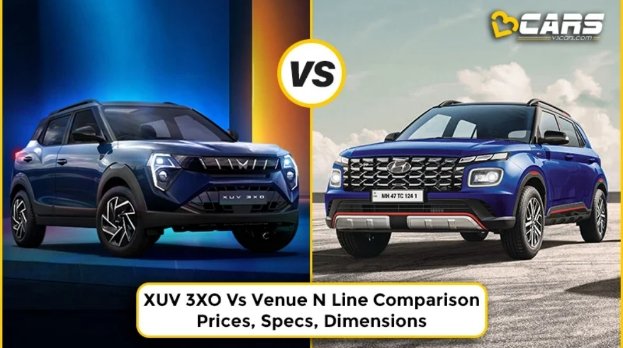In the competitive compact SUV segment, the Mahindra XUV 3XO RevX A AT and Hyundai Venue N Line N6 DCT stand out as sporty, feature-packed options for urban drivers. Both models offer turbo-petrol engines with automatic transmissions, making them ideal for those seeking performance and convenience. Launched with updates in 2025, these vehicles cater to buyers prioritizing style, safety, and efficiency. This detailed comparison breaks down their key specifications, helping you decide which one suits your needs better. Prices start at around ₹12.99 lakh for the Mahindra and ₹12.94 lakh for the Hyundai (ex-showroom, Delhi), positioning them as close rivals.

Design and Dimensions
The Mahindra XUV 3XO RevX A AT boasts a bold, muscular design with sharp lines, LED headlamps, and a panoramic sunroof that enhances its premium appeal. It measures 3990 mm in length, 1821 mm in width, and 1647 mm in height, with a wheelbase of 2600 mm. This provides ample interior space and a boot capacity of 364 litres, ideal for family outings or weekend getaways. The ground clearance stands at approximately 187 mm, ensuring good handling on varied terrains.
In contrast, the Hyundai Venue N Line N6 DCT features a sportier aesthetic with N Line-specific elements like a twin-tip muffler, red accents, and a radiator grille emblem. Its dimensions are slightly different: 3995 mm long, 1770 mm wide, and 1617 mm tall, with a 2500 mm wheelbase. Boot space is 350 litres, and it has a turning radius of 5.1 m for nimble city driving. Both SUVs ride on 16-inch alloy wheels, but the Mahindra’s wider stance gives it a more planted look.
Engine and Performance
Under the hood, the Mahindra XUV 3XO RevX A AT is powered by a 1.2-litre mStallion TGDi turbo-petrol engine, delivering 128.73 bhp at 5000 rpm and 230 Nm of torque between 1500-3750 rpm. Paired with a 6-speed automatic transmission, it offers peppy acceleration and a top speed of around 160 kmph. Fuel efficiency is rated at 18.2 kmpl (ARAI), making it economical for daily commutes.
The Hyundai Venue N Line N6 DCT, on the other hand, uses a 1.0-litre Kappa turbo GDi engine, producing 118.41 bhp at 6000 rpm and 172 Nm of torque from 1500-4000 rpm. Its 7-speed DCT gearbox provides smoother shifts and sporty drive modes, with an ARAI mileage of 18 kmpl. While the Hyundai feels agile in traffic, the Mahindra’s higher torque gives it an edge in highway overtakes.
Interior Features and Comfort
Inside, the Mahindra impresses with a 10.25-inch touchscreen infotainment system supporting wireless Android Auto and Apple CarPlay, a matching digital cluster, and Adrenox Connect for remote features. Comfort highlights include ventilated front seats, automatic climate control, cruise control, and a cooled glovebox. The leatherette upholstery and rear AC vents ensure a premium cabin experience.
The Hyundai counters with sporty black interiors accented by red inserts, an 8-inch touchscreen with connected tech, and features like ambient lighting, wireless charging, and a single-pane sunroof. It also offers drive modes, a dashcam with dual cameras, and leatherette seats. Both provide USB ports front and rear, but the Mahindra’s larger screens and panoramic sunroof make it feel more luxurious.
Safety Features
Safety is a strong suit for both. The Mahindra XUV 3XO RevX A AT boasts a 5-star Global NCAP rating, with 6 airbags, ESC, TPMS, ISOFIX mounts, and a rear camera. Additional aids include hill hold assist and auto-dimming IRVM.
The Hyundai Venue N Line N6 DCT matches with 6 airbags, ABS with EBD, ESC, hill assist, and a TPMS. It adds a dashcam and anti-pinch power windows. Both ensure peace of mind, but Mahindra’s superior crash test scores give it a slight advantage.
At similar pricing, the Mahindra offers more power, space, and a panoramic sunroof, making it ideal for families. The Hyundai excels in sporty styling and refined DCT transmission for enthusiasts. Choose based on your priority—raw performance or dynamic handling.
In conclusion, both SUVs deliver value in the sub-4m category, blending technology and safety. Test drive them to see which aligns with your driving style in 2025’s evolving market.
